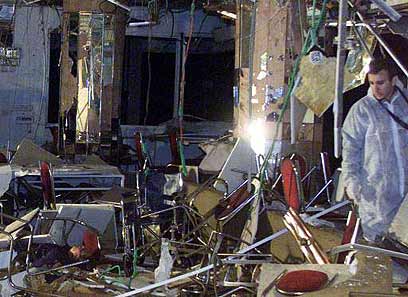
The al-Aqsa Intifada
None
The al-Aqsa Intifada is the name commonly used to describe a series of violent clashes between the Palestinians and Israel in the timeframe between 2000 and 2004. The al-Aqsa Intifada is considered to be one of the pivotal security-related events of the past few years, as it affected nearly every aspect of both the Israeli and Palestinian way of life.
Violent erupts
The catalyst which brought on the al-Aqsa Intifada is believed to be a visit by then-Prime Minister Ariel Sharon to Temple Mount, in late September 2000. The visit was viewed as an intentional attempt by Israel to infringe on the Muslim presence on Temple Mount, and met with a violent riot which left 10 Palestinian demonstrator and 25 Israeli policemen injured.
The following October saw a series of violent riots sweep through the Arab sector in Israel. The week-long riots, later dubbed the "October Riots," left one Israeli and 13 Israeli-Arabs dead and are considered to be a social breaking point in the relationship between the State of Israel and its Arab citizens.
The mass riots among Israeli Arabs eventually subsided, only to be replaced by thousands of sporadic violent incidents by Palestinians, who used firearms, explosive devices and mortar fire against Israel. The violence escalated further, as Palestinian terror groups began carrying out relentless suicide attacks against Israeli targets. The al-Aqsa Intifada would see 138 suicide attacks by late 2004, claiming numerous lives.
_wa.jpg)
Unrest. 2000 riot in Umm al-Fahm (Archives: Yariv Katz)
Israel's response to the attacks grow more and more aggressive, going from imposing curfews and financial sanctions on the Palestinian Authority, to setting up roadblocks, constructing a security fence and mounting targeted assassinations of known terror operatives. Eventually, in 2002, Israel launched Operation Defensive Shield and took over the West Bank.
Pivotal event
- In October 2000, two IDF reservists inadvertently wondered into the West Bank city of Ramallah. The two were captured by a Palestinian mob, taken to the city's police headquarters, tortured and murdered while the crowds cheered. Footage of the lynching sent shockwaves through the Israeli public and prompted the IDF to pursue more aggressive actions against terrorists.
- On Friday June 1, 2001, a suicide bomber blew himself up at the Dolphinarium nightclub on Tel Aviv's promenade. The gruesome attack claimed the lives of 21 teenagers and left 132 wounded.
- August 9, 2001 saw a suicide bombing at the Sbarro pizzeria in Jerusalem. Fifteen people were killed and 140 were injured.
- On October 17, 2001 then-Tourism Minister Rehavam Ze'evi was assassinated by terrorists at Jerusalem's Hyatt hotel.
- The first week of December 2001 saw 26 Israelis murdered in two suicide bombings in Haifa and Jerusalem. Later that month, Israel declared the Palestinian Authority "a terror entity" and proceeded to siege the West Bank and obliterate the Gaza airfield and then Palestinian President Yasser Arafat's fleet of helicopters.
- January of 2002 saw the capture of Karin A – a seaborne arms vessel meant for the Palestinian Authority – by Israeli naval commandos. Dubbed Operation Noah's Ark, the seized ship was found to be harboring 50 tons of weapons and explosives, including mid-range Katyusha rockets, antitank missiles, rifles and launchers and countless amounts of ammunitions.
- In Passover of 2002 a Hamas suicide bomber blew himself up in the Park Hotel in Netanya, slaying 30 and wounding 150. Two days after the attack, Israel launched Operation Defensive Shield.

- During the military campaign, IDF forces operating in the West Bank arrested Fatah Secretary-General Marwan Barghouti. A subsequent trial found him guilty of five counts of murder and he was sentenced to five consecutive life terms and an additional 40 years (190 yeas in total).
- In June 2002 Israel began construction on the security fence. Once finished, the fence will stretch 473 miles.
- On June 22, 2002 the Israeli Air Force bombed the Gaza home of Salah Shehade head of Hamas' Izz al-Din al-Qassam Brigades in the Strip. The one-ton bomb leveled the entire building, killing 16 people and injuring dozens of others.
- June 29, 2002 saw a US-brokered ceasefire – the "Hudna" – take effect. Meant to last three months and allow Israel and the Palestinian Authority to try and reestablish their relations, the fragile armistice came to an end within seven weeks.
- On October 14, 2003 a female suicide bomber targeted the Maxim restaurant in Haifa. The blast killed 19 Israelis, including six children.
- March of 2004 saw one of the most grievous attacks in Israel's history: Two terrorists disguised as IDF soldiers infiltrated the Ashdod Port and detonated massive explosives. Both blasts took place mere yards of the port's ammonia tanks, which were spared by pure luck. Ten people were killed and 16 were injured. Had the ammonia tanks been compromised, Israel would have been facing a catastrophe of national proportions.

Anti-Israel protest in Nablus (Archives: Reuters)
Following the attack in Ashdod the government sanctioned the targeted assassinations of Hamas leaders. The IDF promptly targeted two – long-time leader Ahmed Yassin and his second in command Abdul Aziz Rantisi.
The increasingly ailing Yasser Arafat died in France in mid November. Soon after his death the bulk of the violence began fizzling out.
According to defense establishment data, the al-Aqsa Intifada claimed the lives of 319 Israeli soldiers and 745 civilians, and left 2,430 soldiers and 5,032 civilians wounded.
According to the B'Tselem human rights group and Red Crescent Data the Palestinian suffered 3,315 fatalities and 29,181 casualties.










